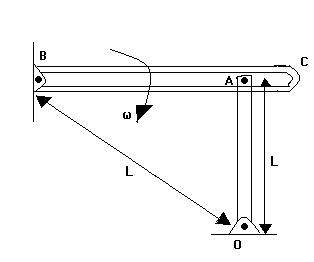i got answer as 2wl
and yes the figure should be an isoceles triangle

The Figure shows two rods BC and OA hinged from B and O respectively. Rod BC has a groove in which A of rod OA can slide smoothly. At a given instant,the rod BC has an angular velocity ω. The speed of end A of the rod OA at this instant will be
(A) ωl
(B) 2ωl
(C) 3ωl
(D) None of these
I simply couldnt understand the question.. Please help me figure out this problem.....
aree u sure both these lenghts are L
if that is the case the diagram should have been an isoceles triangle..
as i see it the asnwer is either 2wl or none of these..
The component of the velocity of A in the Y direction is given.. we know that A moves perpendicular to the Rod OA.. so u have a hint?
i got answer as 2wl
and yes the figure should be an isoceles triangle
CAn u plz say just few point on it....how to proceed
yahi hai jo nahi bana :P
see what is the direction of motion of A..
and what is the direction in which u know the velocity of A..
What is the angles between thse directions
ab ho jaega :)
Uff ab ban gaya figure hi ganda tha paper me.
i didn't saw that its equilateral triangle
jada time chemistry me hi de diye the :(
this problem is solved by making a LOT of wrong assumptions
fiitjee gives such confusing probs in the name of innovating new ones
dont worry iitjee will test ur correct concepts
edit
sorry after seeing rohans elegant sol
i feel i was mislead by the dia
ne way my fault to misread
its a real good q if dia was proper
see one thing is known
the rod's length cant change
so the velocity of A can only be in the perpendicular direction of OA
let angle √OAB=θ
then AB=2Lcosθ
so velocity of A in perpendicular direction =2Lcosθw
let velocity of A belonging to OA =v
so we get vcosθ=2wLcosθ (as they are both along the perpendicular and the same)
so v=2wL